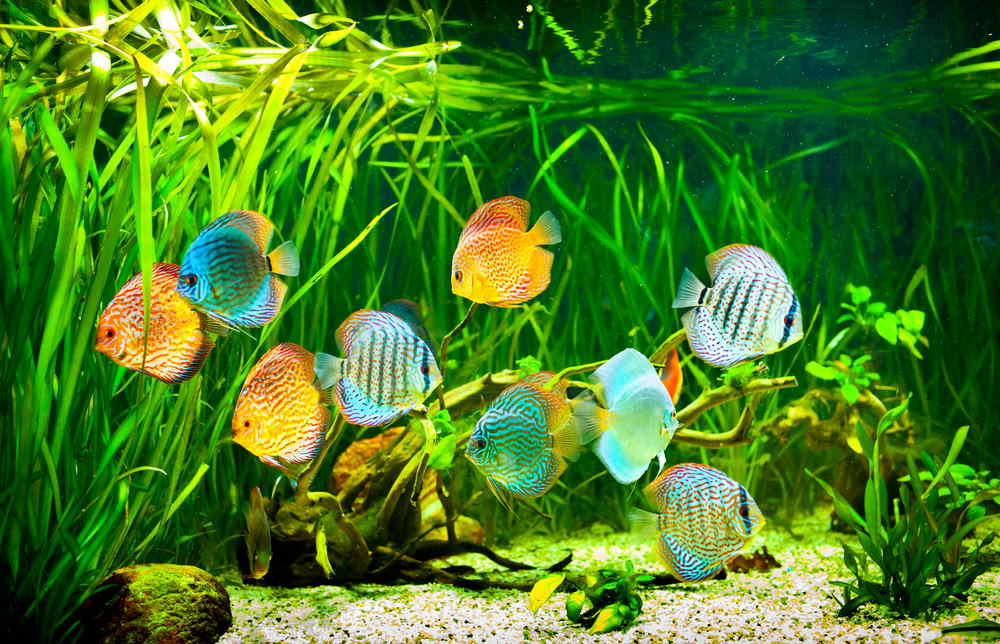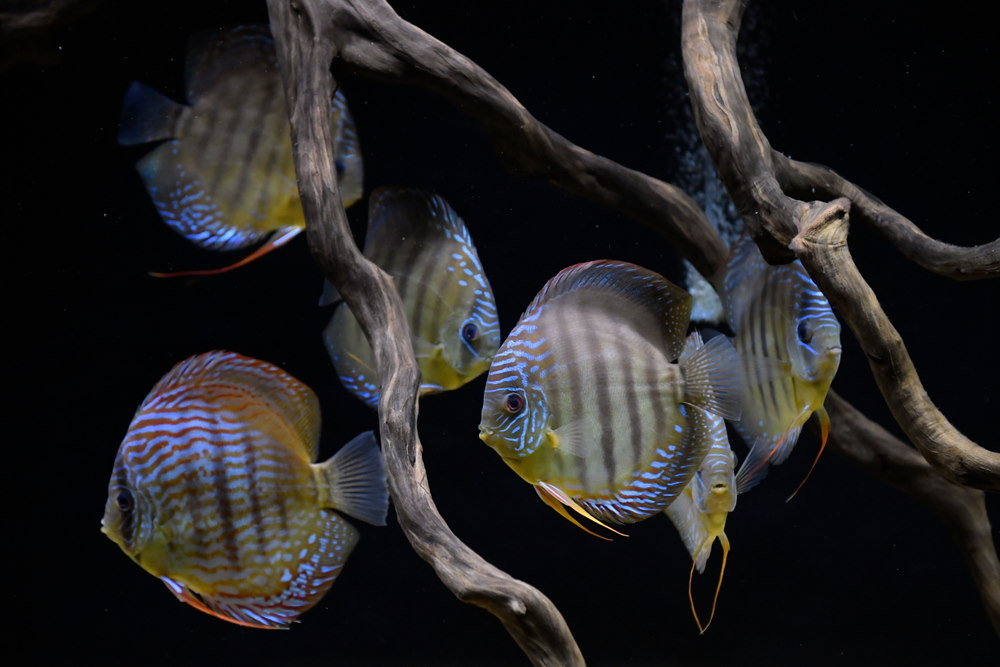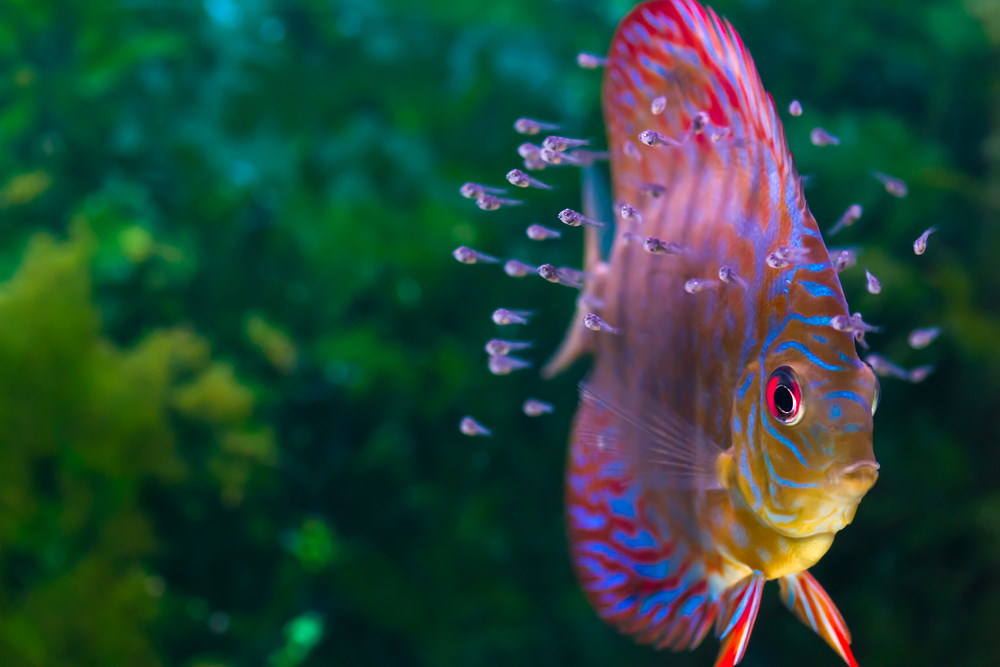Care Guide for Discus Fish – The King of the Aquarium
Discus fish are one of the most beautiful freshwater fish in the hobby, known for their spectacular colors and large, circular shape. However, they’re notorious for being extremely difficult to keep, with Internet forums often recommending strict practices like 100% water changes every day. In reality, only a small percentage of people are able to follow those rules, and the rest of the world uses more low maintenance methods. We’ve spent many years keeping discus personally at home, caring for them in our fish store, and helping customers be successful with them. Based on our experiences, this care guide offers practical advice and useful tips for beginners starting their first discus tank.
What Is the Ideal Temperature for Discus Fish?
The easiest trick for keeping happy discus is to raise the water temperature. We highly recommend 85 to 86°F. The reason is because the discus farms we get them from usually keep their waters at these temperatures, and when we try to force them to cool down, it becomes a source of discomfort. When the heat is kept high, your discus become more active, their metabolisms run well, they grow faster, and they show off better colors. So if you want to successfully care for discus, be willing to make this necessary change, which may differ from your normal fish keeping habits.
Other environmental conditions to consider include pH and water hardness. The recommended pH can be controversial since many people place great emphasis on this factor. In our experience, both wild-caught and captive-bred discus do well when the pH levels are between 6.8 and 7.6. The same thing applies with water hardness; discus are usually fine with soft to medium hardness. We haven’t kept German-bred discus yet, but they’re known for tolerating higher pH and harder water. If you’re focused on breeding and raising discus fry, you need much lower pH and water hardness, but if you’re simply keeping them for enjoyment, these two water parameters aren't as important.

Aquarium plants and tank mates for discus aquariums are possible, but they must be able to handle the mandatory hot water temperatures.
What Size Tank Do You Need for Discus?
Bigger is always better, so we personally recommend a 75-gallon aquarium or larger. You can do a 55-gallon tank, but then you’re forced to do a lot of water changes. Remember that these fish get big, usually 5 to 7 inches in diameter if you’re doing things right. Also, by heating up the tank, their metabolism goes up, you have to feed them more, and then more waste is created. (That’s why people recommend doing all those frequent water changes.)
Many customers ask us, “Can I keep one discus?” Technically, the answer is yes. For example, dogs are technically pack animals, yet many people keep just one and then leave them home all day by themselves. It’s not ideal, but it’s doable. The same thing applies with discus.
However, they are schooling fish by nature and are much happier when surrounded by a large group of their own kind. Plus, as a type of cichlid, they may start to bully each other if you don’t a decent-sized group. In order to mitigate this territorial aggression, buy 10 to 12 juveniles all at the same time for your 75-gallon tank. (You want them to be approximately the same size so that no one gets outcompeted for food.) As they get bigger, you’ll be able to identify the rowdy males and rehome them back to the fish store. Eventually, you should end up with a nice, relatively peaceful group of six adult discus with mostly females and maybe a couple of males.
As for tank setup, you can put them in a planted tank, but make sure to find plants that can tolerate high temperatures, such as anubias, java fern, bacopa, sword plants, and micro swords. We also recommend adding air stones since the higher water temperature decreases the amount of oxygen in the water. In the summer when the weather gets hotter than normal, an air stone can help decrease the risk of having low oxygen levels.

Start with a larger school of juvenile discus and then remove the most aggressive ones over time.
Do Discus Really Need Daily Water Changes?
It depends. Remember that the purpose of water changes is to remove waste buildup. Therefore, the amount and frequency of water changes really varies for every aquarium. Several considerations include how large your tank is, how many fish you have, how much you feed them, and how much biological filtration (e.g., beneficial bacteria and live plants) you have. As a general rule of thumb, we recommend keeping the nitrate level lower than 40 ppm for planted tanks and lower than 20 ppm for non-planted tanks.
To figure out how often you need to do water changes on your aquarium, get an aquarium water test kit and download our free infographic that guides you step-by-step through the process.
What Fish Can Be Kept With Discus?
Tank mates must meet two criteria: they should be able to live in high temperatures and they cannot outcompete the discus for food. In general, discus are slow feeders, so if you put them with speedy, bullet-shaped fish (like barbs or even huge schools of tetras), the discus will tend to lose that race. Even other hot water fish like clown loaches, German blue rams, and angelfish can be too fast for them.
Instead, consider starting with a discus only tank where they are the centerpiece fish. Once you get them eating well, consider gradually adding cardinal tetras, Sterbai cory catfish, or maybe a bristlenose pleco. However, avoid getting too many tank mates, or else the discus may lose out on nutrition.

Cardinal tetras are a popular tank mate for discus tanks, but don’t get so many that they outcompete the discus for food.
What Is the Best Food for Discus Fish?
Most people feed them foods that are way too big, not realizing that discus mouths are quite small. Therefore, if you see them eating the food, spitting it out, and then mouthing it again, you may have a problem with the size of the food.
Frozen bloodworms are great because their skinny shape is perfect for slurping up, but discus can get addicted to them quite easily. Make sure to feed them a wide variety of small foods to cover all the nutrients they need. We’ve had good luck with prepared foods like Hikari Vibra Bites, Sera Discus Granules, Tetra Discus Granules, and Hikari Discus Bio-Gold. Other suggestions include frozen or live brine shrimp, live or freeze-dried blackworms, and live microworms.
Why Are Discus Fish so Expensive?
We hinted at this previously, but tank conditions must be pristine for breeding and raising fry. It’s very time- and labor-intensive work, especially since discus take longer to reach full adult size compared to other cheaper fish like guppies. You can buy discus from local breeders, fish stores, or even online, but if you’ve never kept discus before, our best advice is to stay away from the price extremes. In other words, don’t buy the cheapest ones that may have quality issues, and don’t buy the $300 adults that may die from your lack of experience. Just remember to purchase a group of them that are all the same size to minimize bullying.

Keeping discus for fun is much easier than the high-maintenance care required for breeding and raising discus fry.
How Do You Keep Discus Fish Happy?
The main takeaway from this care guide is to reduce stress. Raise the heat, keep the water clean and stable, and feed them correctly. Don’t let kids tap on the glass, and limit the amount of traffic near their tank. Also, don’t put their aquarium right next to the TV with lots of loud noises and flashing lights. Anything you can do to help these shy creatures feel safe will go a long way in enhancing their health and quality of life.
Finally, don’t forget to reduce your own stress! A lot of beginner discus owners spend too much time worrying that they’ll accidentally harm their discus, instead of relaxing and appreciating their majestic beauty. With these simple guidelines, you’re on your way to having a successful, enjoyable discus tank for many years to come.
Want to read more blog posts like this? Subscribe to our e-newsletter to stay up to date on our latest articles, videos, events, and more.




